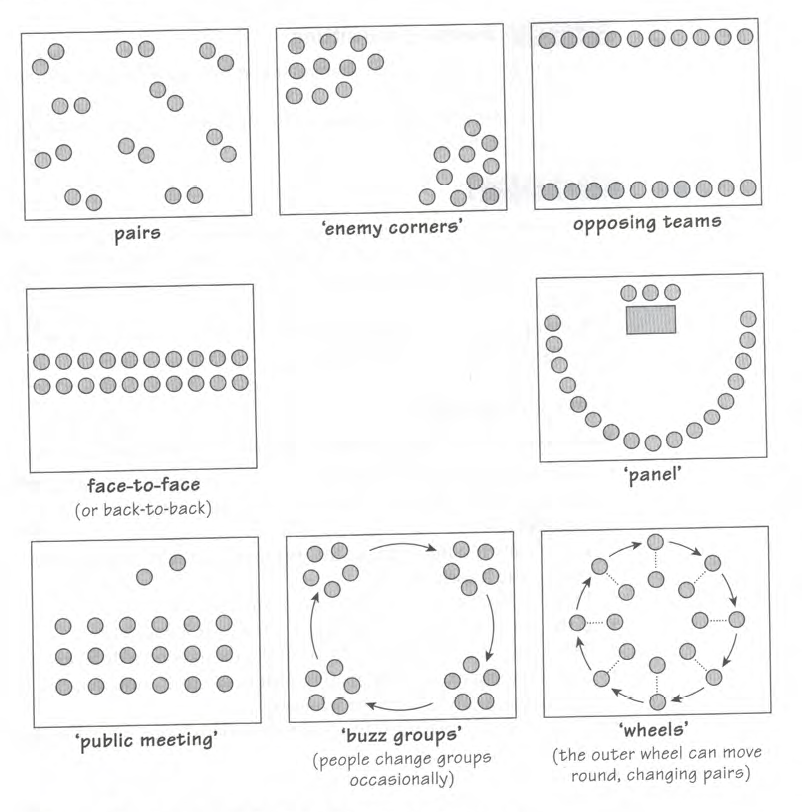When it comes to ELT methodology and English language teaching, it’s hard to imagine how many books we can find. One of the books I really like and find quite useful both for novice and experienced teachers is “Learning Teaching” by Jim Scrivener. It’s one of the most popular guides to English Language Teaching. It’s a complete, well-structured book that includes many ideas and techniques you can put into practice.
There are 16 chapters.
- Starting out.
This chapter describes different teachers, classrooms, the subject matter of ELT, various methods and gives hints and strategies for the first lesson. What I really like in this part is classroom snapshots, where you can see and analyse the atmosphere, the learners’ mood, the teacher’s attitude, etc.
- Classroom activities.
This chapter tells about activities’ route map and planning, pairwork and small group work. I really like pairwork and group work in class and I enjoyed reading the part about different types of tasks for pairwork.
- Classroom management.
This chapter covers classroom interaction patterns, seating, instructions, monitoring, gestures, using the board, eliciting and things that prevent learning. I would say it’s one of the biggest challenges for teachers, but especially for novice ones. The whole chapter is full of useful and handy information, but I really liked seating possibilities in the classroom. Teachers don’t pay enough attention to it and almost never think about that. But it can benefit language learning a lot.

- Who are the learners?
In this chapter, you’ll learn more about individuals and groups, their needs levels, their training and how you can get feedback from learners. What I found particularly useful was a part about Multiple Intelligence by Howard Gardener. It’s quite important to consider different learning styles and preferences when thinking about lesson design, activities to meet all students’ opportunities and needs, etc.
- Language analysis.
This chapter tells you about analysing English grammar, grammatical forms and meaning; analysing the meaning of words, communicative function. I like the part about analysing concepts. That’s what usually causes a problem: meaning in context, collocations, relationship between words.
- Planning lessons and courses.
This chapter tells how people learn languages, how it’s better to sequence lesson components. It covers lesson aims, lesson and course planning. One of the best parts of this chapter is “How do people learn languages?”, the sequence, the process of learning, students’ progress when they learn a new item.

- Teaching grammar.
Here you can find information about how we can present, clarify and practise grammar; how you can do restricted output, such as drills, exercises, games, dialogues. The part that I really like is about Guided Discovery. It includes many examples of questions for guided discovery worksheets that are so useful! Another part is the variations of drill. We all know drilling is quite boring for many students, but if you add variety, it can become a lot of fun,
- Teaching lexis.
This chapter covers ideas of presenting lexis, lexical activities and games, lexis and skill work, how to remember lexical items and what it means “to know a lexical item”. The part that must be beneficial is “What are some things you can know about a lexical item?” Many teachers think if students know the meaning or the translation of a word, they know it and can use it. But it’s not that easy. You need to know the spelling, register, connotation, collocations, colligation, and many other things.
- Productive skills: speaking and writing.
In this chapter, you learn about different approaches to teaching speaking and writing; communicative activities and role-plays; the difference between speaking for accuracy and fluency; different kinds of speaking; how to organise writing in class. The part I found interesting is about genres as it directly influences the appropriacy of lexis and grammar.
- Receptive skills: reading and listening.
This chapter includes information about approaches to listening and reading; some ideas for activities; some information about how students listen and extensive reading. This chapter gives some great ideas for listening tasks (jigsaw, news headlines, the gallery, guest stars, live listening, home recording, etc.)
- Phonology: the sound of English.
Here you’ll find information about pronunciation, sounds, word stress and connected speech. Pronunciation is one of the topics frequently disregarded by many teachers. In this chapter, I found a lot of useful information about modelling, shadow reading, chants. How to teach pronunciation, prominence, etc.
- Focusing on language.
This chapter describes how to do error correction, how to use dictionaries, timelines, how to do testing, and the use of L1. What I think can be quite helpful for many teachers is activities that make use of L1. Scrivener gives a list of few ideas on that.
- Teaching different classes.
This chapter covers information about all types of classes: ESP, EAP, Business English, Exam classes, Young Learners, CLIL, Teenage classes, Large classes. Each part is quite specific and if you teach certain types of classes, there’s something new you still can find in the book.
- Using technology.
In this chapter, you’ll learn more about interactive whiteboards, presentation software and learning online.I wouldn’t say this part is quite modern and up-to-date as technology keeps changing and it’s hard to follow sometimes. But still, there’s some ideas that can be put into practice.
- Tools, techniques, activities.
This chapter describes how to use flashcards, organise picture stories, integrate storytelling, work with songs, use fillers, organise lexical games, do dictation, organise drama, poetry and projects; how we get to know a class.
- Next steps.
This chapter shows the benefits of observing and being observed, of giving and getting feedback; advantages of self-reflection. I like the self-assessment part as I think self-assessment is one of the best and the most useful things for teachers’ professional development. There’s a huge list of things you can consider and focus during the lesson and improve your lessons.
This book will definitely help all the teachers to extend their knowledge of teaching and methodology, I’m sure it’ll help teach more effectively.






 Маргарита Аветисян
Маргарита Аветисян 
 Вероника Аветисян
Вероника Аветисян 


